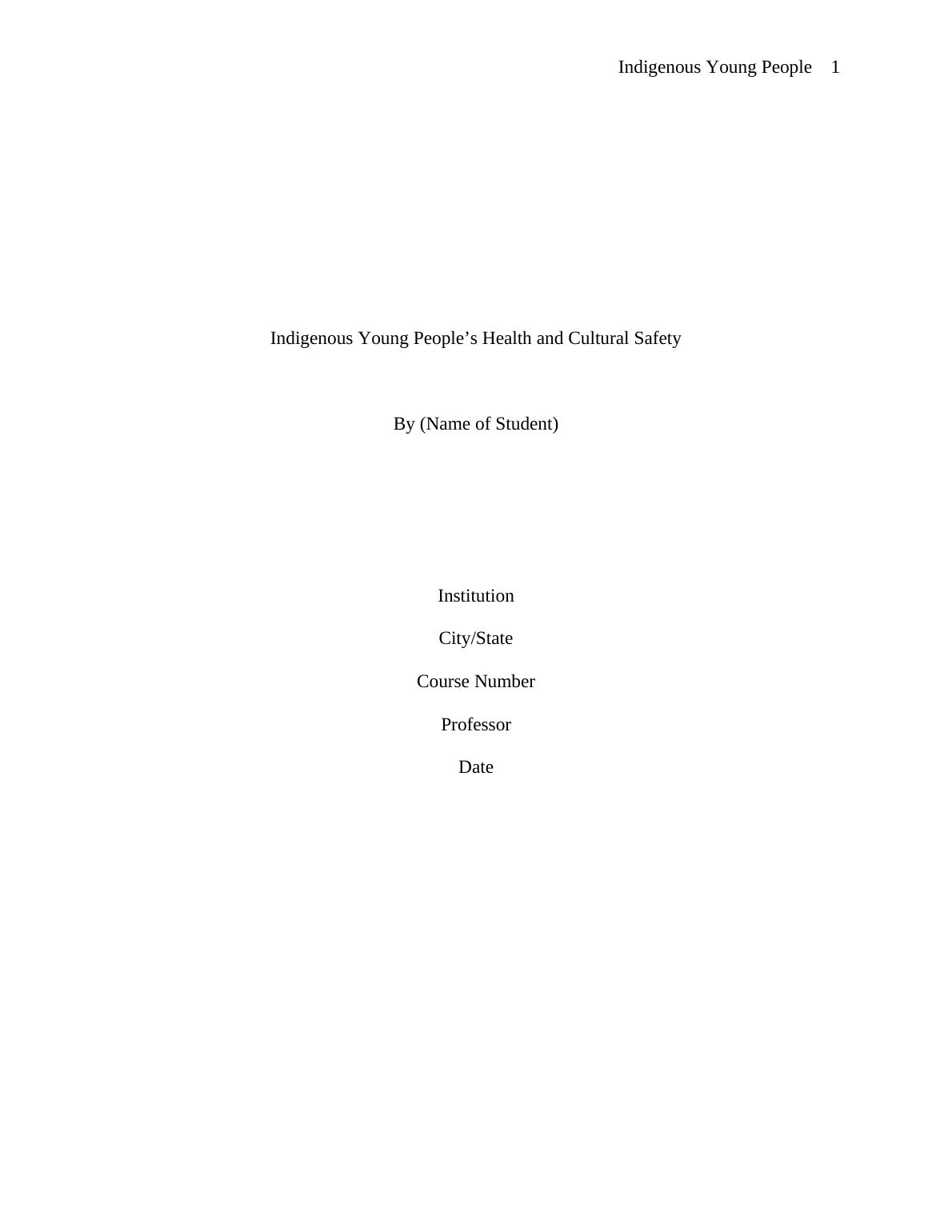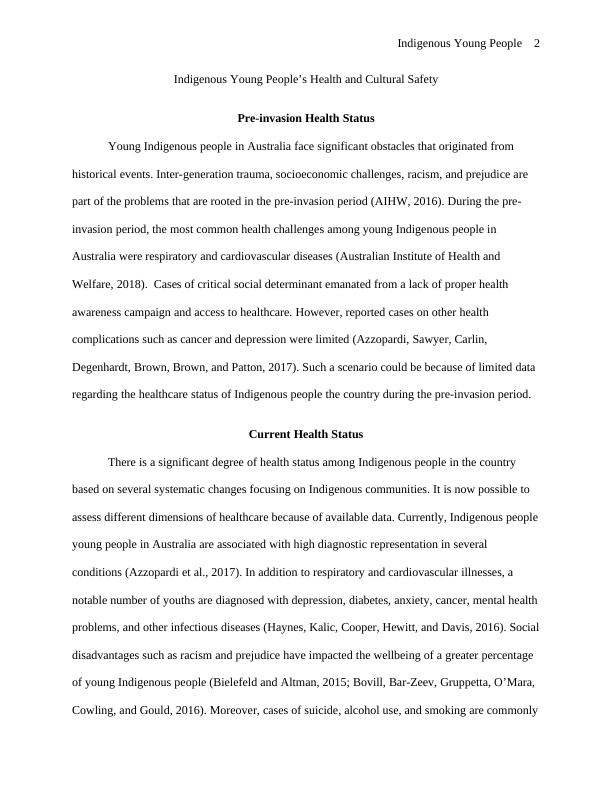Indigenous Young People Case Study 2022
Added on 2022-10-18
10 Pages2863 Words7 Views
Indigenous Young People 1
Indigenous Young People’s Health and Cultural Safety
By (Name of Student)
Institution
City/State
Course Number
Professor
Date
Indigenous Young People’s Health and Cultural Safety
By (Name of Student)
Institution
City/State
Course Number
Professor
Date

Indigenous Young People 2
Indigenous Young People’s Health and Cultural Safety
Pre-invasion Health Status
Young Indigenous people in Australia face significant obstacles that originated from
historical events. Inter-generation trauma, socioeconomic challenges, racism, and prejudice are
part of the problems that are rooted in the pre-invasion period (AIHW, 2016). During the pre-
invasion period, the most common health challenges among young Indigenous people in
Australia were respiratory and cardiovascular diseases (Australian Institute of Health and
Welfare, 2018). Cases of critical social determinant emanated from a lack of proper health
awareness campaign and access to healthcare. However, reported cases on other health
complications such as cancer and depression were limited (Azzopardi, Sawyer, Carlin,
Degenhardt, Brown, Brown, and Patton, 2017). Such a scenario could be because of limited data
regarding the healthcare status of Indigenous people the country during the pre-invasion period.
Current Health Status
There is a significant degree of health status among Indigenous people in the country
based on several systematic changes focusing on Indigenous communities. It is now possible to
assess different dimensions of healthcare because of available data. Currently, Indigenous people
young people in Australia are associated with high diagnostic representation in several
conditions (Azzopardi et al., 2017). In addition to respiratory and cardiovascular illnesses, a
notable number of youths are diagnosed with depression, diabetes, anxiety, cancer, mental health
problems, and other infectious diseases (Haynes, Kalic, Cooper, Hewitt, and Davis, 2016). Social
disadvantages such as racism and prejudice have impacted the wellbeing of a greater percentage
of young Indigenous people (Bielefeld and Altman, 2015; Bovill, Bar-Zeev, Gruppetta, O’Mara,
Cowling, and Gould, 2016). Moreover, cases of suicide, alcohol use, and smoking are commonly
Indigenous Young People’s Health and Cultural Safety
Pre-invasion Health Status
Young Indigenous people in Australia face significant obstacles that originated from
historical events. Inter-generation trauma, socioeconomic challenges, racism, and prejudice are
part of the problems that are rooted in the pre-invasion period (AIHW, 2016). During the pre-
invasion period, the most common health challenges among young Indigenous people in
Australia were respiratory and cardiovascular diseases (Australian Institute of Health and
Welfare, 2018). Cases of critical social determinant emanated from a lack of proper health
awareness campaign and access to healthcare. However, reported cases on other health
complications such as cancer and depression were limited (Azzopardi, Sawyer, Carlin,
Degenhardt, Brown, Brown, and Patton, 2017). Such a scenario could be because of limited data
regarding the healthcare status of Indigenous people the country during the pre-invasion period.
Current Health Status
There is a significant degree of health status among Indigenous people in the country
based on several systematic changes focusing on Indigenous communities. It is now possible to
assess different dimensions of healthcare because of available data. Currently, Indigenous people
young people in Australia are associated with high diagnostic representation in several
conditions (Azzopardi et al., 2017). In addition to respiratory and cardiovascular illnesses, a
notable number of youths are diagnosed with depression, diabetes, anxiety, cancer, mental health
problems, and other infectious diseases (Haynes, Kalic, Cooper, Hewitt, and Davis, 2016). Social
disadvantages such as racism and prejudice have impacted the wellbeing of a greater percentage
of young Indigenous people (Bielefeld and Altman, 2015; Bovill, Bar-Zeev, Gruppetta, O’Mara,
Cowling, and Gould, 2016). Moreover, cases of suicide, alcohol use, and smoking are commonly

Indigenous Young People 3
reported among individuals between the age of 12 and 24 (Australian Institute of Health and
Welfare, 2018).
Assimilation Policy
Assimilation policy is a key historical occurrence that impacted young Indigenous people
and as well as children and adults. In 1960, the Australian government enacted the policy whose
objective was to ensure that Indigenous people are assisted to adopt a modern lifestyle and be
part of the Australian mainstream community (Commonwealth Government, 1961). The policy
highlighted how and why it as necessary to teach and influence Indigenous people to accept
Whites’ way of life so that they could also enjoy similar rights and opportunities as non-
Indigenous people. Indigenous people were therefore required to abandon their traditional
practices and start observing modern customs, hopes, and beliefs (Commonwealth Government,
1961). It was believed that this transition could improve and advance the political, social, health,
and economic lifestyle of Indigenous people. Nevertheless, the impact of the policy exacerbated
the social and health status of young Indigenous people.
Assimilation Policy
Racism and Identity
As noted earlier the purpose of the assimilation policy was to provide a framework for
Indigenous people to be absorbed into the mainstream community as they abandon their culture
and Indigenous practices. However, the implementation of the policy provided a platform for
increased racism and loss of identity. First, ‘full-blood’ Indigenous people were expected to ‘die
out’ so the policy targeted non-‘full-blood’ young people and children of Aboriginal and Torres
Strait Islanders origin. Children were separated from families and young people disintegrated
from respective communities. Indigenous people were considered a threat to the society and
reported among individuals between the age of 12 and 24 (Australian Institute of Health and
Welfare, 2018).
Assimilation Policy
Assimilation policy is a key historical occurrence that impacted young Indigenous people
and as well as children and adults. In 1960, the Australian government enacted the policy whose
objective was to ensure that Indigenous people are assisted to adopt a modern lifestyle and be
part of the Australian mainstream community (Commonwealth Government, 1961). The policy
highlighted how and why it as necessary to teach and influence Indigenous people to accept
Whites’ way of life so that they could also enjoy similar rights and opportunities as non-
Indigenous people. Indigenous people were therefore required to abandon their traditional
practices and start observing modern customs, hopes, and beliefs (Commonwealth Government,
1961). It was believed that this transition could improve and advance the political, social, health,
and economic lifestyle of Indigenous people. Nevertheless, the impact of the policy exacerbated
the social and health status of young Indigenous people.
Assimilation Policy
Racism and Identity
As noted earlier the purpose of the assimilation policy was to provide a framework for
Indigenous people to be absorbed into the mainstream community as they abandon their culture
and Indigenous practices. However, the implementation of the policy provided a platform for
increased racism and loss of identity. First, ‘full-blood’ Indigenous people were expected to ‘die
out’ so the policy targeted non-‘full-blood’ young people and children of Aboriginal and Torres
Strait Islanders origin. Children were separated from families and young people disintegrated
from respective communities. Indigenous people were considered a threat to the society and

End of preview
Want to access all the pages? Upload your documents or become a member.
Related Documents
Teaching and Learning in Aboriginal Education - SPlg...
|13
|3617
|445
Health Care of Aboriginals and Torres Strait Islanderslg...
|12
|3195
|7
Australian Indigenous Young Peopleslg...
|12
|3039
|262
Policy of Assimilation 1961: Impact on Health Outcomes of Australian Indigenous Young Peopleslg...
|13
|3460
|255
Impact of Health Policies on Indigenous Australians in Australialg...
|9
|2623
|239
Aboriginal and Torres Strait Island Culture PDFlg...
|11
|3107
|207
